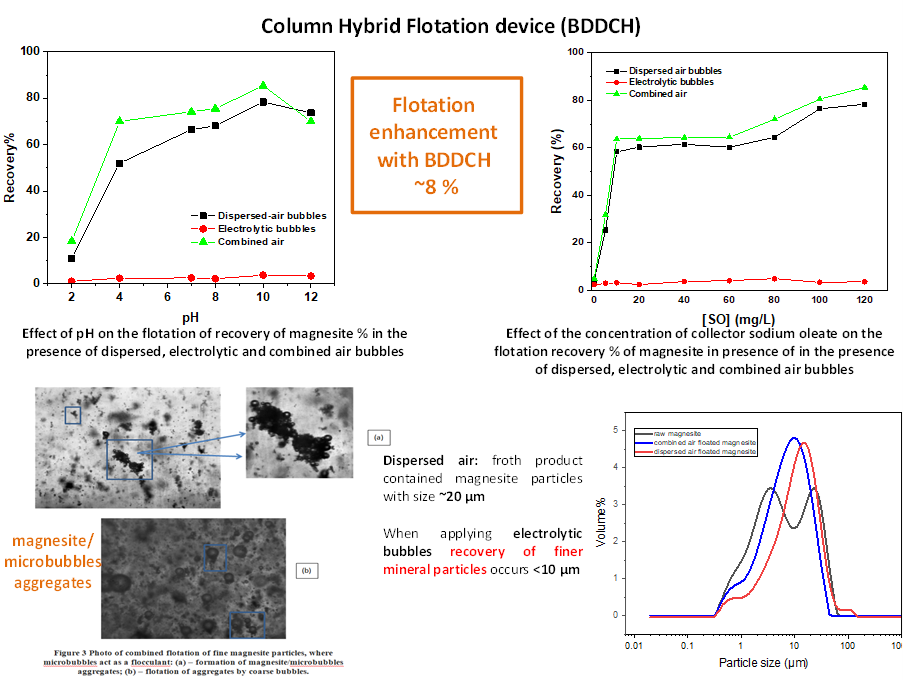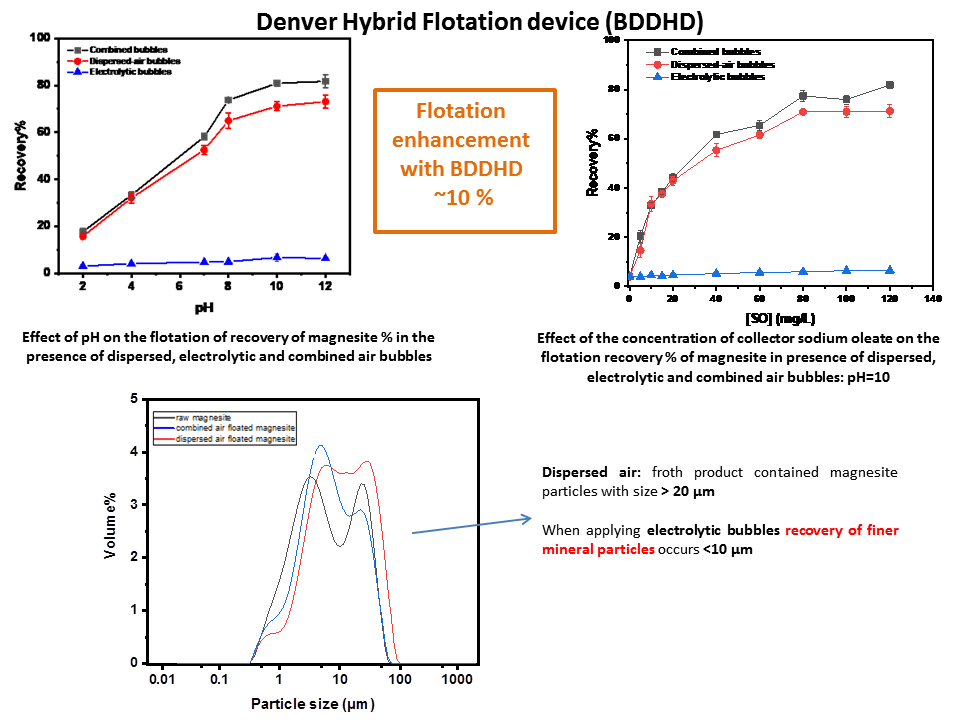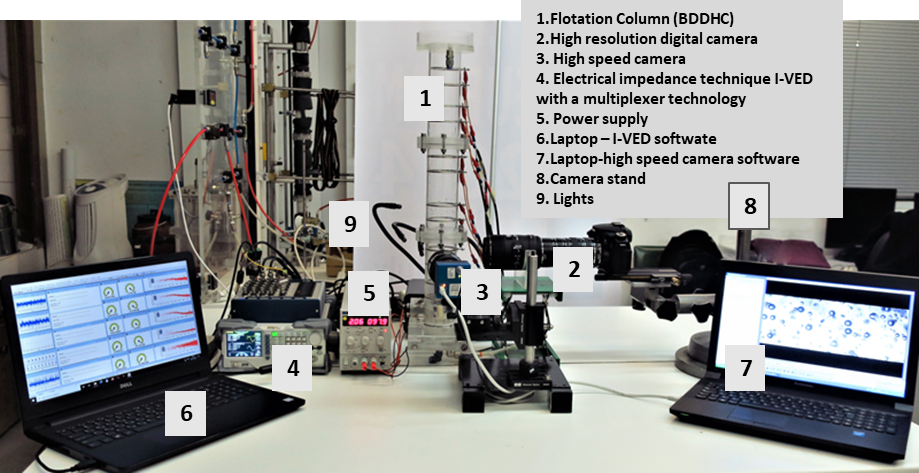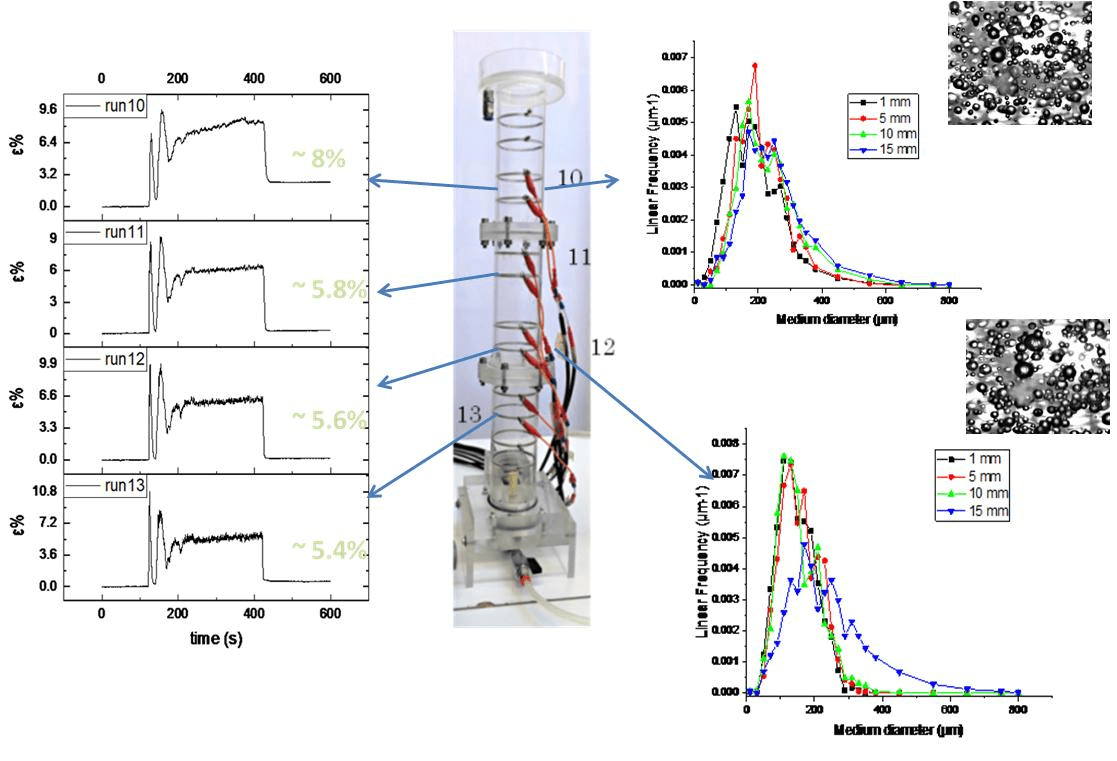Contact Person: O. Oikonomidou [rania.oik@gmail.com], Paulina Tsave [tsavpoly@chem.auth.gr]
The overall aim of the present research project is to create new scientific knowledge and develop groundbreaking technologies in order to enhance the recovery of fine sized particles with the process of flotation.
Viscoelastic interfacial properties of liquid-gas systems involving in a flotation process
The first part of this work studies the viscoelasticity of bubbles surface in a flotation system. In flotation process, different surfactants are used 1) as collectors, to make the mineral particles hydrophobic and facilitate bubble-particle collision and 2) as frothers, to decrease the size of bubbles and to enhance the formation of a stable foam that encounters the recovered mineral particles.
Based on literature, the binary mixtures of ionic – nonionic surfactants feature enhanced interfacial properties compared to the individual ionic and nonionic surfactant components [1]. In terms of minerals flotation technology, these binary mixtures can be used as collector reagents and they are expected to improve bubble-particle attachment efficiency and thus facilitate the recovery of mineral particles.
Up to date, the synergistic action of ionic and nonionic surfactant molecules, has been studied by performing static surface tension measurements. For the first time, the present work tests interaction between sodium oleate (NaOl, anionic primary collector) and five different ethoxylated/ alkoxylated alcohols (nonionic co-collectors) by measuring the interfacial shear viscosity of their aqueous solutions at a wide range of shear rates. Measurements are conducted at 30°C using a Physica MCR 301 Anton Paar rheometer equipped with an interfacial rheology system (IRS) employing a bicone bob geometry, as shown in Figure 1 [2]. Various anionic-nonionic mass ratios from 95:05 to 50:50 are tested, keeping the concentration of NaOl constant at 1CMC.
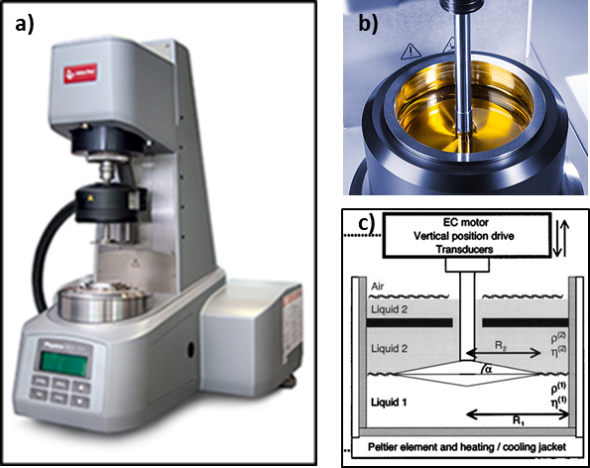
Figure 1. a) Anton Paar Physica MCR 301 rheometer, b) Interfacial Rheology System (IRS) equipped with bicone bob geometry, c) schematic description of the interfacial examination in the present experimental setup
Results show that nonionic molecules tend to displace NaOl molecules from the air/liquid interface. Upon some critical nonionic concentration, interfacial shear viscosity of the binary mixture is governed by the nonionic molecules, indicating that these molecules occupy the interface. Critical concentration level changes with the chemical structure of nonionic molecules, i.e. length of the hydrophilic head, branch at the hydrophobic chain. However, supporting surface tension measurements show that at this critical concentration there are still NaOl molecules attached on the interface. Static surface tension of the studied systems are measured with TE2 LAUDA Tensiometer, using the Wilhelmy plate method.

Figure 2. Critical concentrations of the Dodecyl Ethoxylate 03 nonionic co-collector, above which the NaOl anionic molecules are displaced from the air/liquid interface, as indicated by both interfacial viscosity and static surface tension measurements
Oscillatory rheological runs reveal the dominant viscous character of all tested binary mixed monolayers with only a marginal elastic component (Figure 3). The Linear Viscoelastic Region of this systems is quite short (<0.3%).
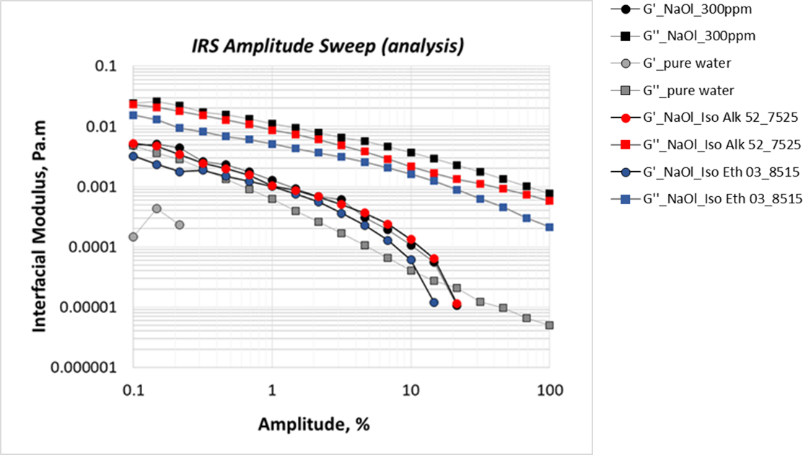
Figure 3. Storage (G’) and Loss (G’’) moduli amplitude sweep measurements at 1rad/s oscillation frequency, for NaOl and Isotridecyl Alkoxylate 52 or Isotridecyl Ethoxylate 03 systems at their critical mass ratios
Bubble-particle collision frequency in turbulent mineral flotation
In another aspect, this work aims to develop a generalized framework for the bubble-particle collision frequency in the turbulent flows of flotation systems. For this, the already existing collision frequency models are unified, to examine and assess properly all the relevant physical principles and fundamental theories. The developed generalized framework, models the pulp phase from device scale to thin film scale separating bubbles and particles. The core of this model is the term describing the collision frequency between bubbles and particles (Figure 4). All existing approaches are examined in detail and critically commented demonstrating several inconsistencies. A unified and consistent approach for deriving this collision frequency term is described, overcoming all the inconsistencies of previous approaches. The obtained results refer to the case of dispersed air flotation of fine particles, being practically the only case for which a collision frequency expression of algebraic complexity can be derived.
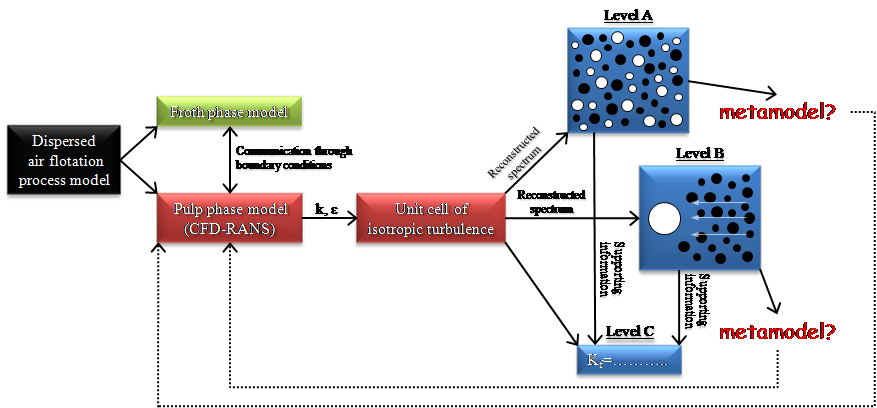
Figure 4. General structure for the flotation cell model focused on pulp phase. Bubbles are shown in white and particles in black (not to scale for clarity of presentation)
Furthermore, the development of a robust mean field model (based on the existing population balance models of flotation) aims to simulate flotation in turbulent flow field. The increased sophistication of mathematical models depicting industrial processes requires advancement both in terms of expressing the state of participating materials and of describing their spatial distributions. In case of dispersed systems, the appropriate mathematical tools for such an advanced representation are the population balance equations and the computational fluid dynamics algorithms. In the presence of turbulence the situation is even more difficult because turbulence affects all size scales of the problem. Since the direct simulation of turbulence is impracticable with the present computational means, a large effort in modeling turbulent interactions is required. The present work is the follow up of a series of two recent works on the development of expressions for turbulent collisions frequency between bubbles and particles. Here, the whole route for transferring the localized collision information to the real-world device scale is presented, accounting for the dynamics of bubbles and particles populations (Figure 5). A particular procedure to (i) select the state and independent variables, (ii) select the occurring process, and (iii) mathematically reduce the multivariate population balance system after careful inspection of the problem in each stage of development, is proposed. The procedure is applied to a relatively complicated specific flotation process with the aim of demonstrating its details. A spatially homogeneous system of ordinary differential equations is derived and several results are illustrated in order to expose its usefulness.
Fine minerals recovery due to hybrid mechanical-electrolytic flotation
The third part of the project focuses on the development of an innovative flotation technology to intensify the attachment between fine mineral particles and gas bubbles and hence, enhance flotation performance. The proposed technology is based on existing experimental evidence showing that bubble–particle collision efficiency and fine particles flotation recovery increases with the decrease of bubbles size. For this, the design and operation of two hybrid flotation systems able to produce bubbles with different diameters is accomplished. A micro-bubble generator (electrolysis unit) is adapted on a mechanical flotation device (BDDHD) (Figure 6) and on a flotation column (BDDHC) (Figure 7) and the resulting hybrid devices operate by combining dispersed-air bubbles and micro-bubbles from water electrolysis. The significance of this process is that micro-bubbles attached on the hydrophobized surface of fine particles assist the attachment of conventional-sized bubbles and subsequently increase the flotation recovery of particles.
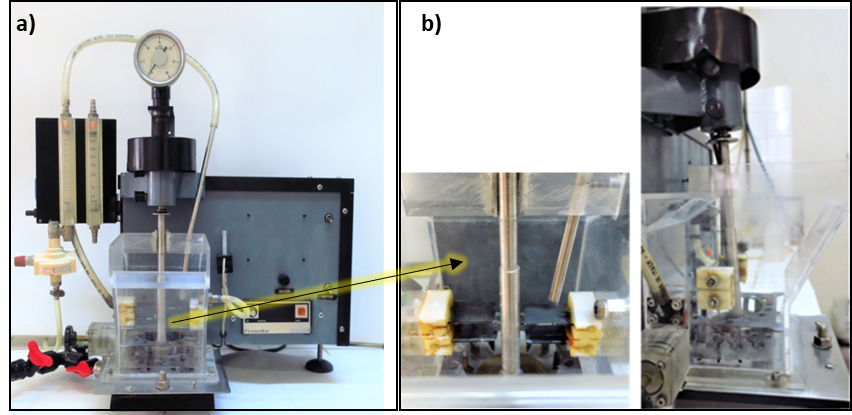
Figure 6. a) Hybrid mechanical flotation device, BDDHD, (b) 2 Electrolysis units placed on the inner walls of the flotation cell
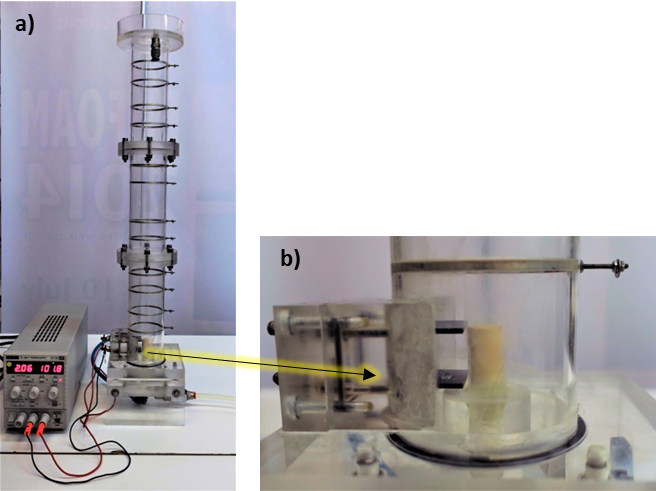
Figure 7. a) Hybrid electroflotation column, BDDHC, (b) Electrolysis unit adapted on the flotation column
The computed recovery of the particles after each flotation experiment is an indicator of the process efficiency. Experimental flotation results of the hybrid devices, so far indicate the enhancement of fine particles recovery by approximately 8-10%, due to the addition of micro-bubbles (Figure 8,9).
Furthermore, gas phase involved in the flotation process is characterized using both optical and electrical diagnostics (Figure 10). The optical diagnostics (high resolution still digital camera & high speed camera, light scattering method) are employed to determine the bubble size distributions (Figure 11), bubble trajectories, and moreover the turbidity of the flotation medium. A unique, patented, electrical impedance spectroscopy technique, equipped with a multiplexer, is applied for the determination of the volumetric gas fraction distribution along the flotation column.

